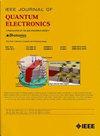基于自动化智能设计系统的高饱和功率超快光电二极管
IF 2.1
3区 工程技术
Q3 ENGINEERING, ELECTRICAL & ELECTRONIC
引用次数: 0
摘要
逆设计算法的快速发展和高速计算资源的日益可用性使得利用启发式算法辅助光子器件的设计成为可能。本文提出了一种半导体光电探测器的自动化智能设计系统,该系统能够识别任意材料分布下光电探测器的最佳性能。采用上述方法设计了一种改进型单行载波光电探测器(MUTC-PD),其带宽为232GHz(@-5V),射频输出功率为16.799dBm(@100GHz)。与原结构和传统手工扫描方法相比,该器件的带宽分别提高了96GHz和25GHz,说明了该方法的有效性和优越性。此外,该系统还有助于发现新的材料组合和结构设计,从而推动半导体光电探测器技术领域的创新和进步。本文章由计算机程序翻译,如有差异,请以英文原文为准。
Ultrafast Photodiodes With High Saturation Power Based on an Automated Intelligent Design System
The rapid development of inverse design algorithms and the increasing availability of high-speed computing resources have made it possible to exploit heuristic algorithms to assist the design of photonic devices. This paper presents an automated intelligent design system for semiconductor photodetectors, which is capable of identifying the optimal performance of the photodetector under arbitrary material distribution. The aforementioned method was employed for the design of a modified uni-traveling carrier photodetector (MUTC-PD), exhibiting a bandwidth of 232GHz(@-5V) and an RF output power of 16.799dBm(@100GHz). In comparison to the original structure and traditional manual scanning methods, the bandwidth of this device has been increased by 96GHz and 25GHz, respectively, which serves to illustrate the effectiveness and superiority of this approach. Furthermore, the system is also instrumental in the discovery of new material combinations and structural designs, thereby driving innovation and advancement in the field of semiconductor photodetector technology.
求助全文
通过发布文献求助,成功后即可免费获取论文全文。
去求助
来源期刊

IEEE Journal of Quantum Electronics
工程技术-工程:电子与电气
CiteScore
4.70
自引率
4.00%
发文量
99
审稿时长
3.0 months
期刊介绍:
The IEEE Journal of Quantum Electronics is dedicated to the publication of manuscripts reporting novel experimental or theoretical results in the broad field of the science and technology of quantum electronics. The Journal comprises original contributions, both regular papers and letters, describing significant advances in the understanding of quantum electronics phenomena or the demonstration of new devices, systems, or applications. Manuscripts reporting new developments in systems and applications must emphasize quantum electronics principles or devices. The scope of JQE encompasses the generation, propagation, detection, and application of coherent electromagnetic radiation having wavelengths below one millimeter (i.e., in the submillimeter, infrared, visible, ultraviolet, etc., regions). Whether the focus of a manuscript is a quantum-electronic device or phenomenon, the critical factor in the editorial review of a manuscript is the potential impact of the results presented on continuing research in the field or on advancing the technological base of quantum electronics.
 求助内容:
求助内容: 应助结果提醒方式:
应助结果提醒方式:


